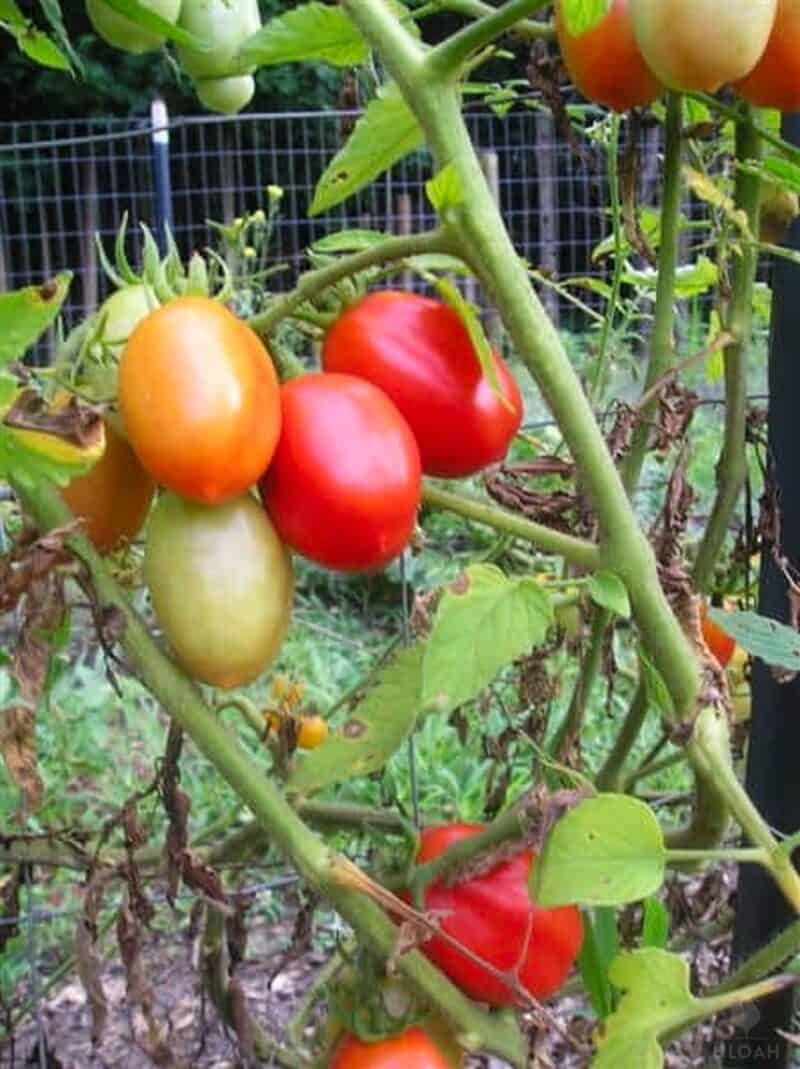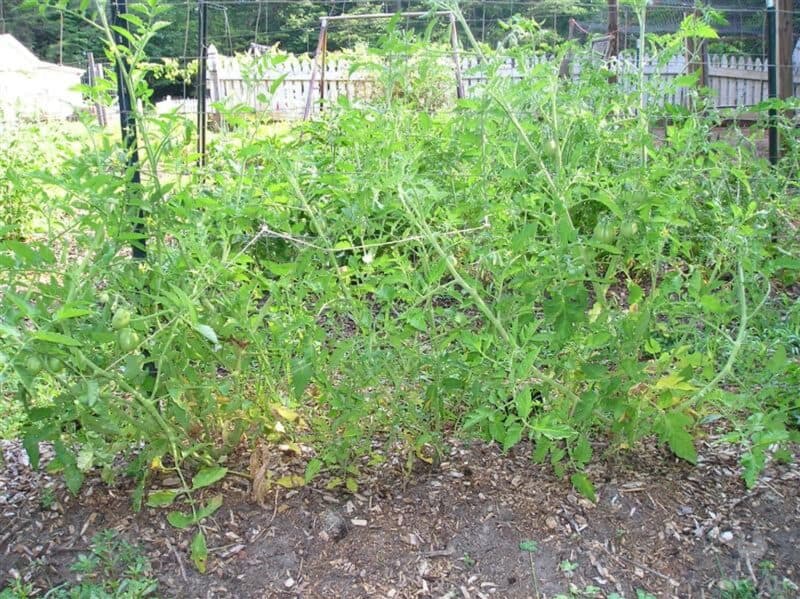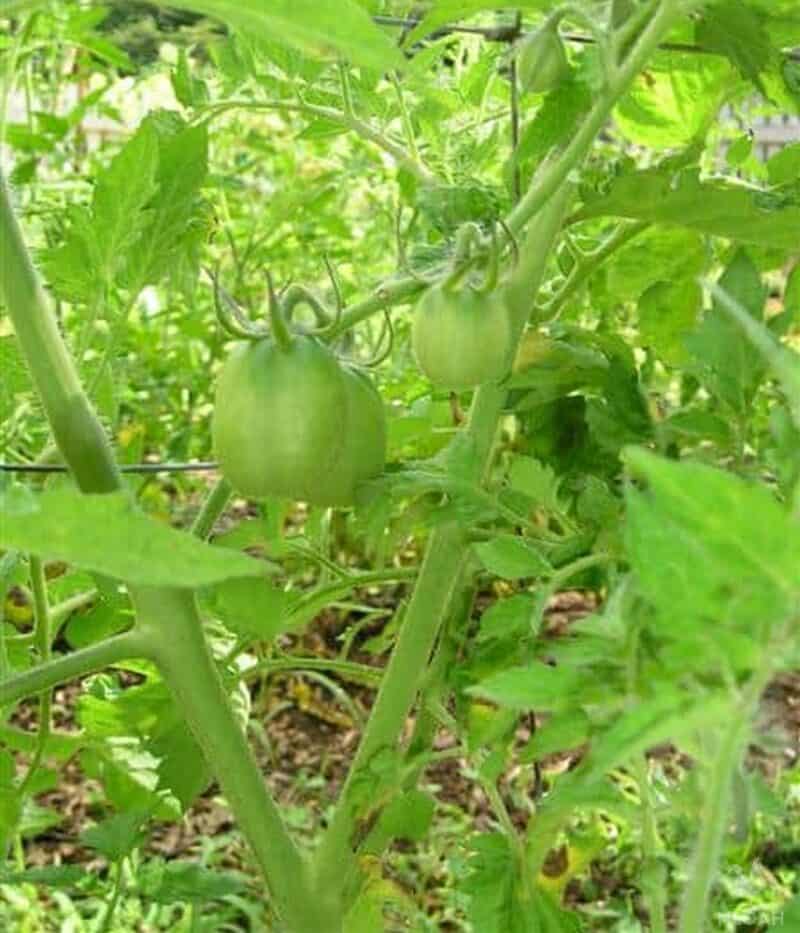Growing tomatoes is simple. After all, isn’t that why so many gardeners choose to grow them as their first introduction to backyard growing?
Unfortunately, it’s a bit more complicated than simply watering and fertilizing your tomatoes. You also need to truly know your tomato – and whether it is a bush or a vine.
One lesser known fact about tomatoes is that they can be found in two major types – bush and vine. Bush tomatoes are also referred to as determinate tomatoes, while vine tomatoes are frequently called indeterminates.

While both kinds of plants will yield you delicious, juicy fruits, there are some key differences to be aware of in how both produce a crop (and how they need to be cared for).
In this article, I’ll tell you all about the key differences between the two so that you can truly know your tomato: is it a bush or a vine?
Determinate vs. Indeterminate Quick Comparison Table
| Determinate (Bush Tomatoes) | Indeterminate (Vine Tomatoes) |
|---|---|
| they stop growing at some point | they keep growing and growing |
| don’t need vertical support | need vertical support |
| form flowers on the ends | form flowers along the sides of the shoots |
| produce fruits all at once | produce fruits continuously until frost |
What Are Bush Tomatoes (Determinate)?
Determinate tomatoes grow to varying heights, each of which depends on the exact species. While a dwarf determinate will only grow to two feet tall or so, there are other kinds of determinate tomatoes that can grow five feet or more.
Therefore, you shouldn’t be lulled into a false sense of security by assuming that just because you chose a determinate variety of tomato, it won’t grow as tall on you!
Determinate tomatoes have a relatively predictable size, though, and can be grown in a more contained setting. They might not necessarily be small, but you can control them.
Bush tomatoes tend to do well for people who plan on gardening in containers, such as on a patio or porch. These tomatoes thrive in these sorts of conditions because, when you grow in a container, you automatically space your tomatoes farther apart.
Determinate tomatoes really like a bit more spacing! Side tip – if you’re growing in a particularly tight space, consider growing a dwarf variety. As the name implies, it won’t spread quite as wide as other kinds of tomatoes.
Now, that’s not to say that your determinate tomatoes won’t ever need staking. In fact, some large varieties of determinate tomatoes need just as much staking as their indeterminate counterparts.
The more important consideration you need to make when deciding between determinate (bush) and indeterminate (vine) tomatoes is when you want to receive your harvest.
Determinate tomato plants produce their fruit all at once – usually a month after reaching full size. The blossoms will form at the ends of the branches before they form fruit, with all tomatoes on a single branch ripening within a few days of each other.
There are some gardeners who believe that determinate tomatoes don’t have as much flavor as indeterminate tomatoes, but I’m not sure there’s any truth to this. The thought here is that they have less flavor because the plants produce fewer leaves.
Bush Tomatoes Varieties
Looking for delicious bush tomatoes to grow? As I mentioned, bush tomatoes are often faulted for poor flavor, but I’ve never found that to be true. The fruits do tend to be smaller than those of indeterminate tomatoes, but you can really rely on your harvest when it comes around.
One fast-maturing variety to consider is Siberian. This determinate variety produces relatively large, egg-shaped tomatoes that are perfect for salads. You might consider other options like Sophie’s Choice, Glacier, and Ida Gold.
Love cherry tomatoes? You don’t have to go without your fix just to enjoy a more all-at-once harvest! There are some early determinate varieties you can consider, including Tumbling Tom Yellow, Patio Choice Yellow, and Patio Choice Yellow.
Here are a few of my other favorite determinate tomatoes for you to grow:
| Amelia | Top Gun |
| Margherita | Orange Pixie |
| Bush Champion | Shady Lady |
| Grandaddy | New Yorker |
| Roma VF | Marglobe |
| Early Wonder | Beefsteak |
| Sophie’s Choice | Celebrity |
| Baby Cakes | Patio Plum |
| Banana Legs |

What Are Vine Tomatoes (Indeterminate)?
Vine, or vining tomatoes, are a different beast entirely. These plants never stop growing and producing during the growing season. Some can reach up to 15 feet (4.5 meters)! You can’t estimate a harvest based on the size of the plant since they simply never shut off.
Of course, as you might expect, when you’re growing indeterminate tomatoes, you’ll need to put in some trellises or other vertical supports – your typical tomato cages and stakes probably aren’t going to do it.
These plants can be grown in small spaces, though, and close to other plants. They move upwards instead of outwards, so airflow isn’t as much of an issue.
When you grow indeterminate tomatoes, you’ll find that flowers appear at different places along the vine, and you can harvest tomatoes a few at a time as they appear on the stem.
Usually, kitchen gardeners choose indeterminate tomatoes for their gardens because you can pull a few tomatoes at once to use in your salad or other recipes.
If you don’t plan on canning or preserving your harvest, indeterminate varieties are ideal – you won’t have a huge onslaught of ripe tomatoes all at once to deal with.
Fun fact – there are actually some kinds of tomatoes, known as vigorous determinants or “semi-determinate,” that are prized because they produce a single crop, reflower, and then push out an additional second crop. You can really have the best of both worlds with this kind of tomato!
It’s important to note that, although vining tomatoes produce more of an ample harvest throughout the growing season, giving you fresh tomatoes all season long, they do require more hands-on time.
Each plant will produce many side shoots. These can turn into their own plants. You’ll need to remove the suckers beneath the first few clusters of flowers to encourage the plant to continue producing fruit.
Another interesting fact about indeterminate tomatoes is that they are native to tropical highlands.
As tender perennials, they’ll die in most temperate climates once a frost hits. However, if you have access to a year-round greenhouse, you can actually keep these plants producing for up to three years!
Vine Tomatoes Varieties
If vine tomatoes suit your fancy, you will have plenty of options to choose from, too. Remember, you’ll need to add some stakes for support, or else let your tomato plants’ vines run on the ground (though there are some risks to doing this, of course, too). These plants will keep getting bigger, and keep making tomatoes over time.

Here are some of my favorite indeterminate varieties:
| Abraham Lincoln | Matt’s Wild Cherry |
| Goliath | Manapal |
| Big Beef | Amish Paste |
| Clint Eastwood Rowdy Red | Ananas Noire |
| Brandywine | Christmas Grapes |
| Giant Paste | Julia Child |
| Green Grape | Northern Lights |
| Ceylon | Beefsteak Rainbow Mix |
| Arkansas Traveler | Golden Queen |
| Red Calabash |
How to Tell Determinate and Indeterminate Tomatoes Apart
Not sure whether the tomato you have is determinate or indeterminate? Here’s a quick way to figure it out – just look at how the shoots are forming.
If it’s a determinate tomato, it will stop its shoot production when flowers form on the ends. If it’s indeterminate, it will form flowers along the sides of the shoots, but these will continue to grow until a frost.
That’s really the only way you can tell the difference between the two plants. Some determinate varieties develop more leaves than indeterminate varieties. However, the creation of new leaves at branch areas can be found in both kinds of plants.
To make things even more confusing, don’t forget that there are some tomato forms that are semi-determinate and may be somewhat between these two categories in their growth habit.
What About Semi-Determinate Tomatoes?
For most home gardeners, growing semi-determinate tomatoes probably isn’t necessary.
These vigorous plants produce two crops during the growing season, and while they’re great for commercial growers who want to be able to double their tomato production, it probably isn’t a good choice for most home gardens unless you plan on canning or preserving twice during your growing season.
Which Tomatoes Are Easier to Grow: Bush or Vine Tomatoes?
Ultimately, both bush and vine tomatoes can be easy to grow. It really depends on what you call “easy” and whether you’d rather spend more time constantly harvesting and preserving your tomatoes (like I do!) or pruning and trellising your tomatoes (as you will with vine tomatoes).
That said, your care requirements will be similar for both bush and vine tomatoes in that both require regular fertilizing, watering, pruning, and staking.
No kind of tomato is completely without care requirements – so don’t assume that by choosing one kind of tomato you’ll get out of all of your gardening chores entirely!
Should I Grow Bush or Vine Tomatoes?
With determinate tomatoes, you’ll get all or most of your tomatoes within just a month. If you like to harvest a ton of tomatoes all at once, go for a determinate variety.
Who might fall into this category? If you are a commercial grower, then obviously, harvesting all of your tomatoes at once may or may not make sense.
But for a home grower, determinate tomatoes are logical if you plan on preserving a ton of tomatoes (or making things like salsa, tomato sauce, or canned tomatoes).
With indeterminate tomatoes, your harvest will be more sporadic. You may start harvesting tomatoes in June and not finish up until the first frost.
Don’t have a lot of climbing space? Grow determinate varieties. Don’t have a lot of horizontal space? Indeterminate will be better for you. If you grow on a patio or in an apartment garden, go for determinate tomatoes.
Personally, I like growing determinate tomatoes the best. I do a lot of canning and food preservation myself at home, so I like knowing that I’ll get massive batches of tomatoes to preserve all at once. I do eat a few fresh, though, and like having fresh tomatoes for my salads throughout the summer.
I grow a few kinds of each type of tomato, but keep in mind that it doesn’t have to be all or nothing!
If you really want to grow a certain kind of tomato and know that it’s a determinate, consider staggering your planting time, and choosing certain varieties of tomatoes with varying maturity dates. That way, you can enjoy a harvest all season long.
Consider doing the same, or start with just one of either kind. Whichever option you choose, you really can’t go wrong with growing your own juicy, super-sweet tomatoes.

Rebekah is a high-school English teacher n New York, where she lives on a 22 acre homestead. She raises and grows chickens, bees, and veggies such as zucchini (among other things).
